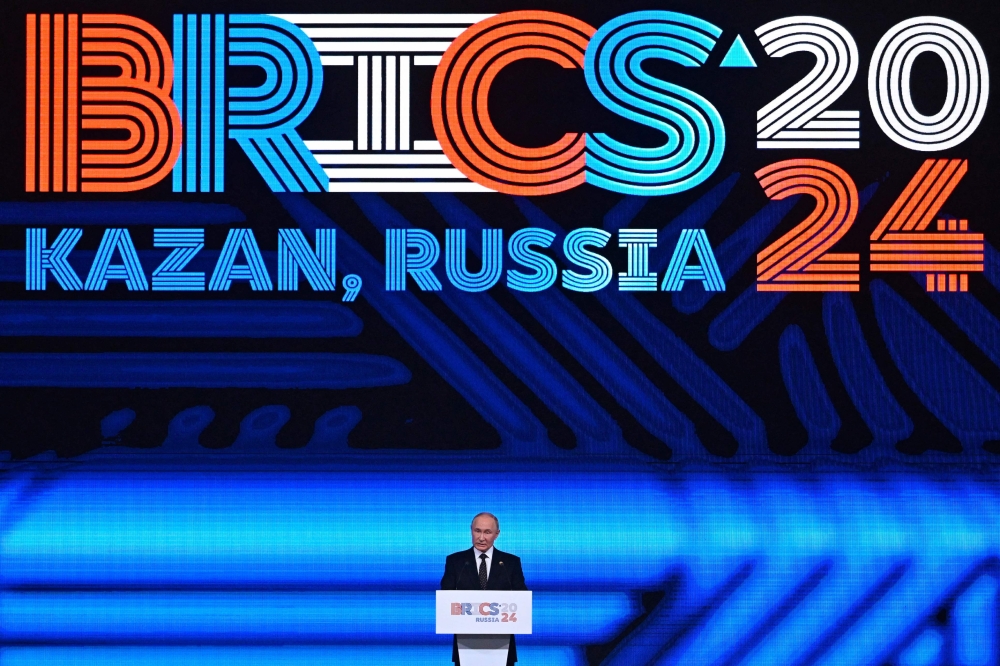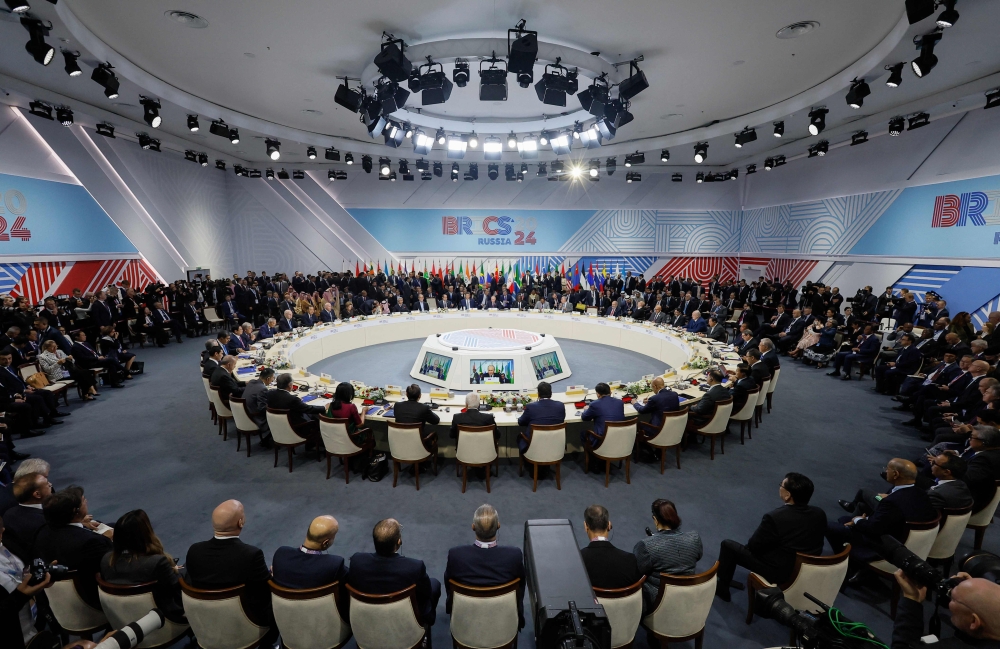
Malaysia is officially a Brics ‘partner country’ now — why, and what does this mean?

Russia’s President Vladimir Putin speaks during a plenary session in the outreach/Brics Plus format at the Brics summit in Kazan on October 24, 2024. — AFP pic
Saturday, 26 Oct 2024 7:00 AM MYT
KUALA LUMPUR, Oct 26 — Malaysia made it as a partner country into the Brics alliance on Thursday, along with neighbours Thailand and Indonesia.
The announcement comes after Prime Minister Datuk Seri Anwar Ibrahim confirmed in July that Malaysia has formally applied to become a Brics member state.
So, what is Brics anyway?
“Brics” started off as just “Bric”, which stood for its founding members Brazil, Russia, India and China.
However, the term was first coined by former Goldman Sachs chief economist Jim O’Neill in his 2001 research paper arguing that the four countries will challenge the global economic monopoly by Western nations.
This was made a reality when the four countries formed the alliance in 2006. When South Africa was invited to join in 2010, the alliance was renamed Brics.
Last year, Brics initiated its first round of expansion and four more countries joined: Iran, Egypt, Ethiopia, and the United Arab Emirates (UAE). The name of the alliance, however, stayed as Brics.
Argentina was also invited but declined. Saudi Arabia has not formally joined, but its participation has been confirmed by South Africa.
Currently chaired by Russia, the bloc comprises 45 per cent of the global population and their combined economies are worth US$26.6 trillion (RM115.7 trillion) — representing 28 per cent of the global economy.
Why is Malaysia eager to join this club?
This latest move seems to be part of Anwar’s continued move to keep Malaysia independent and non-aligned in both economically and geostrategically.
Last month, Anwar said joining Brics will offer “economic opportunities free from external pressures” as he said the alliance seeks to strengthen the “Global South” — a term referring to developing and under-developed countries primarily located in the Southern Hemisphere.
Earlier in June, Anwar told Shanghai-based news site Guancha that Malaysia’s membership in Brics would be of strategic importance since the Straits of Malacca serves as an important shipping route connecting the Pacific and Indian Oceans.
Roughly one-third of the world’s crude oil passes through the Straits of Malacca and Brics member states account for 44 per cent of global crude oil production.

Saturday, 26 Oct 2024 7:00 AM MYT
KUALA LUMPUR, Oct 26 — Malaysia made it as a partner country into the Brics alliance on Thursday, along with neighbours Thailand and Indonesia.
The announcement comes after Prime Minister Datuk Seri Anwar Ibrahim confirmed in July that Malaysia has formally applied to become a Brics member state.
So, what is Brics anyway?
“Brics” started off as just “Bric”, which stood for its founding members Brazil, Russia, India and China.
However, the term was first coined by former Goldman Sachs chief economist Jim O’Neill in his 2001 research paper arguing that the four countries will challenge the global economic monopoly by Western nations.
This was made a reality when the four countries formed the alliance in 2006. When South Africa was invited to join in 2010, the alliance was renamed Brics.
Last year, Brics initiated its first round of expansion and four more countries joined: Iran, Egypt, Ethiopia, and the United Arab Emirates (UAE). The name of the alliance, however, stayed as Brics.
Argentina was also invited but declined. Saudi Arabia has not formally joined, but its participation has been confirmed by South Africa.
Currently chaired by Russia, the bloc comprises 45 per cent of the global population and their combined economies are worth US$26.6 trillion (RM115.7 trillion) — representing 28 per cent of the global economy.
Why is Malaysia eager to join this club?
This latest move seems to be part of Anwar’s continued move to keep Malaysia independent and non-aligned in both economically and geostrategically.
Last month, Anwar said joining Brics will offer “economic opportunities free from external pressures” as he said the alliance seeks to strengthen the “Global South” — a term referring to developing and under-developed countries primarily located in the Southern Hemisphere.
Earlier in June, Anwar told Shanghai-based news site Guancha that Malaysia’s membership in Brics would be of strategic importance since the Straits of Malacca serves as an important shipping route connecting the Pacific and Indian Oceans.
Roughly one-third of the world’s crude oil passes through the Straits of Malacca and Brics member states account for 44 per cent of global crude oil production.

Russia’s President Vladimir Putin delivers a speech during a festive reception of the Brics summit in Kazan on October 23, 2024. — AFP pic
Malaysia also already has robust trade relations with three of Brics’ founding members. China has emerged as Malaysia’s largest trading partner for 15 consecutive years since 2009, with bilateral trade value reaching RM450.84 billion in 2023.
India, meanwhile, has been the largest market for Malaysian palm oil for 10 consecutive years since 2023 and Malaysia is currently its third-largest trading partner in the Asean region.
Russia was also Malaysia’s eighth-largest trading partner among European countries with bilateral trade valued at RM14.22 billion last year.
Yesterday, economy minister Rafizi Ramli told the Brics Plus Summit that the bloc would reap synergies in its trade ties with Asean next year, as Malaysia takes the chairmanship.
What can a ‘partner country’ do?
Besides Malaysia, 12 other countries were recognised as “partner country”: Algeria, Belarus, Bolivia, Cuba, Indonesia, Kazakhstan, Nigeria, Thailand, Turkey, Uganda, Uzbekistan, and Vietnam.
A “partner country” status is meant to assess “how ready they are for full-fledged or any other Brics membership”, Russian presidential aide Yury Ushakov reportedly told Russian news agency Tass on Wednesday.

Malaysia also already has robust trade relations with three of Brics’ founding members. China has emerged as Malaysia’s largest trading partner for 15 consecutive years since 2009, with bilateral trade value reaching RM450.84 billion in 2023.
India, meanwhile, has been the largest market for Malaysian palm oil for 10 consecutive years since 2023 and Malaysia is currently its third-largest trading partner in the Asean region.
Russia was also Malaysia’s eighth-largest trading partner among European countries with bilateral trade valued at RM14.22 billion last year.
Yesterday, economy minister Rafizi Ramli told the Brics Plus Summit that the bloc would reap synergies in its trade ties with Asean next year, as Malaysia takes the chairmanship.
What can a ‘partner country’ do?
Besides Malaysia, 12 other countries were recognised as “partner country”: Algeria, Belarus, Bolivia, Cuba, Indonesia, Kazakhstan, Nigeria, Thailand, Turkey, Uganda, Uzbekistan, and Vietnam.
A “partner country” status is meant to assess “how ready they are for full-fledged or any other Brics membership”, Russian presidential aide Yury Ushakov reportedly told Russian news agency Tass on Wednesday.

Officials attend a plenary session in the outreach/Brics Plus format at the Brics summit in Kazan on October 24, 2024. — AFP pic
At the 2023 Brics Summit in Johannesburg, South Africa, the five nations adopted a procedure for membership expansion. A country seeking to enter the bloc will have to formally convey their intentions to the Brics chair.
The Brics Sherpas (personal representatives of a member state’s leader) and foreign ministers will then consider the application before recommending it to the top leaders.
Since the bloc operates by consensus, a prospective Brics member state must get the unanimous backing of all existing member states to receive an invitation. The invited state must formally convey their acceptance to be part of the bloc.
Currently, Brics has not outlined the scope of engagement for its partner countries.
However, they are unlikely to possess voting rights in Brics affairs that member states enjoy, and their engagement may be limited to selective meetings. It is also unclear if partner countries will be inducted as a full member after a certain probationary period.
In total, nearly 50 countries worldwide have publicly expressed their intention of joining Brics.
At the 2023 Brics Summit in Johannesburg, South Africa, the five nations adopted a procedure for membership expansion. A country seeking to enter the bloc will have to formally convey their intentions to the Brics chair.
The Brics Sherpas (personal representatives of a member state’s leader) and foreign ministers will then consider the application before recommending it to the top leaders.
Since the bloc operates by consensus, a prospective Brics member state must get the unanimous backing of all existing member states to receive an invitation. The invited state must formally convey their acceptance to be part of the bloc.
Currently, Brics has not outlined the scope of engagement for its partner countries.
However, they are unlikely to possess voting rights in Brics affairs that member states enjoy, and their engagement may be limited to selective meetings. It is also unclear if partner countries will be inducted as a full member after a certain probationary period.
In total, nearly 50 countries worldwide have publicly expressed their intention of joining Brics.
To put this into perspective.
ReplyDeleteMalaysia bilateral trade with USA in 2023 was RM 322 Billion.
Malaysia bilateral trade with EU in 2023 was RM206 billion
These two together , RM 528 Billion, dwarfs Malaysia trade with BRICS economies , and are irreplaceable due to their huge scale.
If Malaysia intention to join BRICS is to build opportunities for cooperation with other BRICS economies, without being hostile to anyone else, that is perfect OK.
If Malaysia intention to join BRICS is to build an Anti-Western coalition with other BRICS economies, that is a stupid, self-destructive agenda, and will have a tragic ending for Malaysia.
Wakakakaka…
DeleteSuch an inconsequential fart of economic insight!
Mfer, trades r dynamic & evolving with time & circumstances.
How long ago ASEAN biggest trading partner was UK then US. & now China.
Ooop… keep living in yr static anmokausai dream lah!